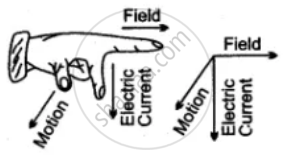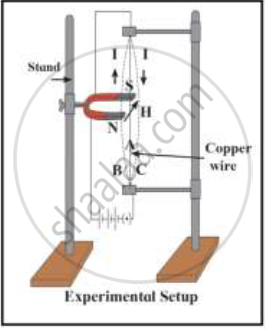Advertisements
Advertisements
प्रश्न
State Fleming's left hand rule.
Name and state the law used to find the direction of force on a current carrying conductor kept in a magnetic field.
उत्तर १

According to this rule, stretch the thumb, forefinger and middle finger of your left hand such that they are mutually perpendicular. If the first finger points in the direction of magnetic field and the second finger in the direction of the current, then the thumb will point in the direction of motion of the conductor or the force acting on the conductor.
उत्तर २
Fleming's left hand rule can be stated as: Stretch the forefinger, the middle finger and the thumb of the right hand, such that they are mutually perpendicular to each other. If the forefinger indicates the direction of the magnetic field, the middle finger indicates the direction of current in the conductor then thumb indicates the direction of force exerted on the conductor.
APPEARS IN
संबंधित प्रश्न
Which of the following property of a proton can change while it moves freely in a magnetic field? (There may be more than one correct answer.)
State qualitatively the effect of inserting an iron core into a current-carrying solenoid.
What is the shape of a current-carrying conductor whose magnetic field pattern resembles that of a bar magnet?
Fill in the following blank with suitable words:
For a current-carrying solenoid, the magnetic field is like that of a ...........
Describe how you will locate a current-carrying wire concealed in a wall.
What are the various ways in which the strength of magnetic field produced by a current-carrying circular coil can be increased?
List three ways in which the magnetic field strength of a current-carrying solenoid can be increased?
When is the force experienced by a current-carrying conductor placed in a magnetic field largest?
State two ways to increase the force on a current-carrying conductor in a magnetic field.
The force experienced by a current-carrying conductor placed in a magnetic field is the largest when the angle between the conductor and the magnetic field is:
45°
60°
90°
180°
A current flows in a wire running between the S and N poles of a magnet lying horizontally as shown in Figure below:
The force on the wire due to the magnet is directed:

fron N to S
from S to N
vertically downwards
vertically upwards
If the current in a wire is flowing in the vertically downward direction and a magnetic field is applied from west to east, what is the direction of force in the wire?
What is the force on a current-carrying wire that is parallel to a magnetic field? Give reason for your answer.
Two coils A and B of insulated wire are kept close to each other. Coil A is connected to a galvanometer while coil B is connected to a battery through a key. What would happen if:
the current is stopped by removing the plug from the key?
Explain your answer mentioning the name of the phenomenon involved.
State condition when magnitude of force on a current carrying conductor placed in a magnetic field is zero?
Name and state the law which is used to determine the direction of force on a current carrying conductor placed in a magnetic field.
i) Which principle is explained in this figure?
ii) Which rule is used to find out the direction of a force in this principle?
iii) In which machine this principle is used? Draw a diagram showing working of that machine

Name and state the rule of determine the direction of force experienced by a current carrying straight conductor placed in a uniform magnetic field which is perpendicular to it.
What does the direction of thumb indicate in the right-hand thumb rule. In what way this rule is different from Fleming’s left-hand rule?
A current-carrying conductor of a certain length, kept perpendicular to the magnetic field experiences a force F. What will be the force if the current is increased four times, the length is halved and the magnetic field is tripled?
